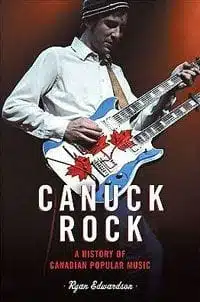
Canadian popular music was, up till about ten years ago, no big shakes. Sure, Canada has always produced a disproportionate range of diverse musical geniuses who would go on to massive commercial and critical success, but almost all of them left the country in order to make it. Neil Young was gone by 1966, same with Joni Mitchell, ditto the Band. These, the greatest “Canadian” artists I can think of, were active in their native land for less than five years.
The persistent exodus of Canadian talent to the US of A was never merely confined to pop music, of course – witness the past and present domination of Hollywood by Canucks, from Mary Pickford to Rachel McAdams. But, since pop music can be made anywhere, and Hollywood films (what with their monstrous budgets) simply can’t, Canadians have tended to fixate on the music thing, stumbling back and forth over this territory in an effort to find an answer to the always already unanswerable question of Canadian identity. If Canada can produce such genius, but doesn’t/can’t/won’t support and nurture this talent, what does that say about the country?
As a Canadian musician, critic, Polaris Prize jurist, and seriously committed music fan, believe me, I’ve had this discussion something like a gabillion times. I wrote my undergraduate honours thesis on “Canadian Artistic Identity and Neil Young’s On the Beach”. I went to a conference last year that was entitled “Are We American?” at which the raft of industry folks and Cultural Studies-y academics came to the resounding conclusion of: I dunno, sort of?
Ryan Edwardson means to help us to understand these problems. He is a talented (and impressively well published) young historian whose previous work has met considerable praise for its reimagining of cultural protectionism – there have been quotas for Canadian content on the airwaves since the early ’70s, sort of like Affirmative Action for Canuck artists – as a liberal project designed to solidify a particular vision of Canadian Identity. This work was fused into an excellent book (Canadian Content: Culture and the Quest for Nationhood, University of Toronto Press, 2006) which demonstrated a nuanced and carefully-researched approach to “culture” in Canada, recognizing the gendered, class-based, and racialized expectations regarding authenticity and identity.
From that lofty perch, Canuck Rock: A History of Canadian Popular Music must be regarded as an unfortunate step backward. Largely gone is the nuance, the careful consideration of class, race, gender, and ethnicity in the formulation of the idea of Canadian artistry – the result is a noticeably lighter read in too many ways. Don’t get me wrong, Edwardson is a fine writer, and his eye for detail is impressive. He collects some wonderful anecdotes, and offers some helpful ways to approach Canadian music and identity in his lucid introduction.
Indeed, Canuck Rock is filled with fascinating tidbits, and will be a lot of fun for fans of such stuff. But although it approaches some enthralling material, including the outraged response to the Beatles’ first concerts in Canada, the development of bohemian “scenes” in the ’60s and their fostering of new ideas and talents, the tension between regionalism and nationalism in such a vast country, and the advent of Much Music (Canada’s answer to MTV) in the ’80s, these discussions feel frustratingly incomplete.
The key problem is probably the brevity of the chapters – at roughly 20 pages each, most aim to cover topics far more complex than such economy allows. One leaves the discussion of Canadian Britishness and Beatlemania, for example, with interest piqued but appetite unsated: did the apeing of Britishness by Canadian pop musicians have anything to do with the wider performative impulse of the period? How, ultimately, can we consider this phenomenon as part of an historical moment in the early ’60s? We get tastes of depth throughout this book, but few instances of sustained interrogation of the issues at hand.
Most unaccountably, Edwardson fails to incorporate much of the available material on issues to which he repeatedly returns. His refusal to engage with the many and varied sources which explicitly tackle the tangled problems of identity politics, performance, and popular music is most confounding – though he does make wide use of sociologist Simon Frith’s work on some of these issues – and there is a persistent lack of theoretical support throughout the book. Moreover, an array of historians and other academics have produced material in the past few years which could have helped to complicate many of the arguments herein, but do not appear in the bibliography. Major questions feel unconsidered, let alone unanswered: How did feminism affect Canadian pop music? What role did race play in the development of hip-hop as a form of “Canadian Content”? How does class complicate the issue of taste, identity, and performance in the Canadian context?
Finally, and most problematically: Edwardson relies far too much on a previous book by journalist Nicholas Jennings – which is, admittedly, among the only full-blown resources on Canadian pop music in the 1960s and 1970s – and in so doing fails to convince this reader that he has uncovered enough new narrative strands, or pushed into enough new interpretive territory. Jennings’ work was seminal, but lacked analysis on key points. Edwardson repeatedly turns to Jennings (his many interviews, and his personal reflections on the pop music scene), but mostly neglects to advance the material.
All of this said, Edwardson’s book should find a wide audience with people hungry for more on the subject of Canadian popular music, and they could do a lot worse than to read this encyclopedic work. While academics might feel a bit deflated at the lack of any grand new discoveries, students and other readers will be rewarded with a collection of exciting material very clearly presented. As the blurb on the back cover from Canadian broadcaster (and former pop star) Jian Ghomeshi proclaims, nicely summarizing my final (if disappointed) analysis: “a book on rock music = fun.”
